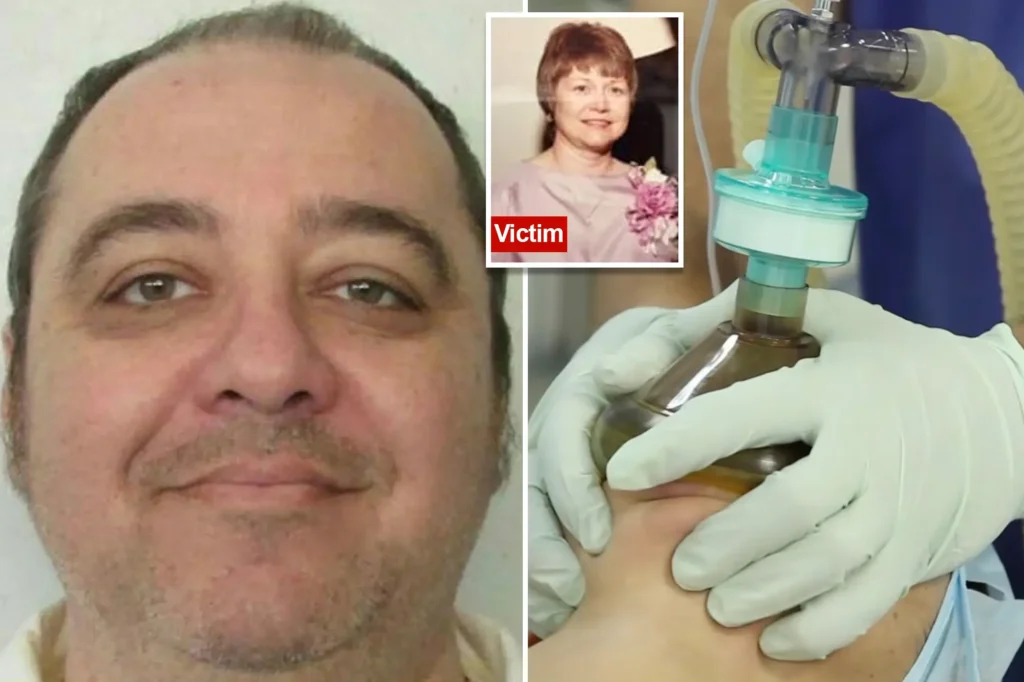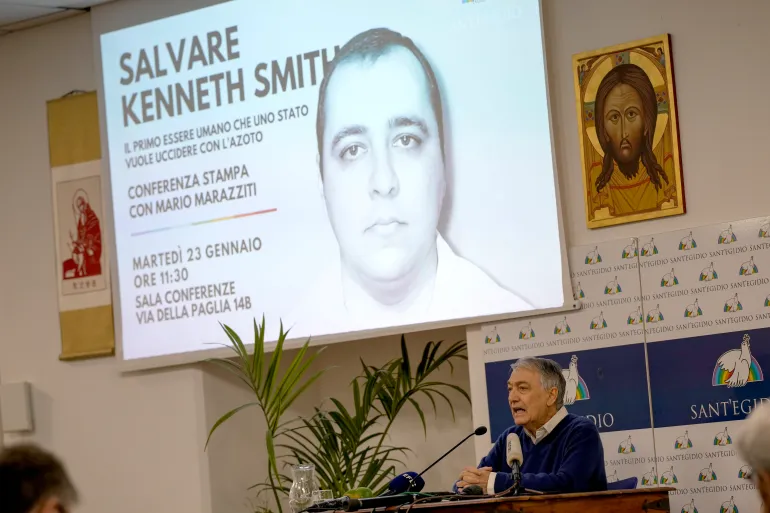In Alabama, Kenneth Eugene Smith was put to death by nitrogen gas in 1988 for a murder-for-hire plot.
Introduction:
In an unsettling and contentious sequence of events, nitrogen gas was used in Alabama to kill Kenneth Eugene Smith. An horrific chapter that began in 1988 when Smith was found guilty of planning a murder-for-hire was closed with the execution. We will examine the minute aspects of Kenneth Eugene Smith’s life, the horrific act that resulted in his conviction, and the contentious manner of his execution that finally decided his destiny in this comprehensive blog article.
Kenneth Eugene Smith was put to death by the state of Alabama on Thursday for the 1988 murder of Elizabeth Sennett under contract.
Pursuant to the Alabama Attorney General’s office, the execution, which was the first ever conducted with nitrogen gas, started at 7:56 p.m. At 8:25 p.m., Smith was declared deceased.
Smith, fifty-eight, spoke last behind a mask that masked his voice.
“Alabama allowed humankind to take an evolutionary retrograde tonight,” said Smith. I value each and every single one of you much. I am grateful for your help.
He was draped in a white sheet up to his chest while wearing his prison uniform, according to witnesses from the media, one of which was an Alabama Reflector reporter. Smith was lying on the gurney with his arms by his sides at a little inclination. His upper chest and his stomach were the two spots where he was fastened down.
A staff worker shut off a valve on the mask, allowing nitrogen to start flowing, after the death warrant was read and Smith’s spiritual advisor, Rev. Jeff Hood, conducted final rites. Smith breathed heavily for seven minutes while convulsing for two minutes and took deep breaths.
It “seemed that Smith was holding his breath as long as he could,” according to John Hamm, commissioner of the Alabama Department for Corrections.
He stated, “All of that was anticipated and in line with the side effects on nitrogen hypoxia that we have observed or studied.”As far as we were concerned, nothing seemed unusual.
Billy Gray Williams, John Forrest Parker, and Smith were recruited by Sennett’s husband, the Rev. Charles Sennett, to kill his wife in order to get insurance money. The house where Elizabeth Sennett was murdered was entered by Parker and Smith. She died, and all three of them were found guilty. Williams received a life sentence and passed away in 2020; Parker was put to death in 2020.
Seven days after the death of his wife, Rev. Charles Sennett committed suicide.
Following the press conference, Michael Sennett, Elizabeth Sennett’s son, stated that Parker and Smith had “been incarcerated almost twice as long as I knew my mom.”
He declared, “We have forgiven all three of the individuals involved in this case years ago—not today, but in the past.”
Smith, who lived through a botched execution in November 2022, had visits from friends and relatives, including his wife, throughout the course of his final 24 hours. He had steak, hash potatoes, and eggs for his last supper.
Smith appealed that the procedure had violated his Eighth Amendment rights against cruel and unusual punishment, but the U.S. Supreme Court denied his requests on Wednesday and Thursday. The trio of liberal justices on the court expressed disagreement.

Smith was chosen by Alabama as its “guinea pig” to test a method of execution that had never been used before because the state had failed to kill him on its first try, according to Justice Sonia Sotomayor. “Everyone is observing.”
“The world is on this impending moral apocalypse,” according to a statement released by Smith and his spiritual advisor, Rev. Jeff Hood, on Thursday afternoon.
The message read, “We pray that people won’t look away.” The suffocating of one another is just not something we can accept as usual.
Killing for pay
Smith’s conviction and death sentence were reversed later on because of his involvement in Sennett’s 1989 death. In 1996, Smith was found guilty once more after a retrial. Smith’s life sentence was suggested by the jury. The trial judge did, however, decide to execute the condemned person instead of the jury.
2017 saw the judicial override practice eliminated by the Alabama Legislature, albeit it was not made retroactive.
At the Holman Correctional Facility, Smith was taken to the death chamber in November 2022 in order to be executed by lethal injection. Approximately ninety minutes before the death warrant was set to expire, the U.S. Supreme Court approved the execution.
The Department of Corrections Department personnel made the decision to postpone the execution because they were unable to set up a backup intravenous line that was required to deliver the deadly medications. Smith was left with many puncture wounds as a result of the procedure, according to his attorneys, and he now suffers from PTSD.
Death due to nitrogen
In 2018, nitrogen executions were authorized by the Alabama Legislature. When midazolam, a sedative used in numerous botched executions, including the 2016 execution of Ronald Bert Smith in Alabama, was used, there was a medication shortage and mounting criticism of the practice in Alabama and other jurisdictions where the death penalty is used.
According to Pittman and other proponents, the nitrogen approach would be more merciful and would enable the state to carry out executions.
Pittman said in September to the Reflector, “You basically black out.” Pain or anything else must wait. Nitrous oxide really acts as a pain reliever to cut down on the number of procedures performed.
In a response, Pittman declined to comment on Thursday.
Anesthesiologists and physicians questioned such finding. Because it might be difficult to keep oxygen out, which can prolong death, the American Veterinary Medical Association discourages using nitrogen for euthanizing animals.
Dr. Radha Sadacharan, a family physician in practice, told the Reflector in September that she couldn’t begin to imagine what it’s like to be in the shoes of someone facing execution, but that waiting for that moment and knowing that you are undergoing an untested method of execution while waiting to suffocate, well, that seems like that would result in an undue amount of suffering.
The technique has also been accepted by Mississippi and Oklahoma, though as of Thursday, no state has scheduled or utilized a nitrogen execution.
Additionally, the 2018 law gave death row inmates 30 days to select their method.
However, the Montgomery Advertiser was informed in 2019 by lawyers and prisoners that they were unaware of the choice until a few days prior to the deadline, which caused misunderstanding.
Attorneys for many death row convicts are from outside of Alabama, and some of them had little opportunity to learn about the potential consequences of a nitrogen execution. In 2021, a federal court referred to the state’s notification as “a mess.”
An appeal
Although Smith indicated in a 2022 court document that he preferred to be executed by nitrogen gas, he did not initially chose this method.

Governor Kay Ivey announced in a statement on Thursday that “the execution was lawfully accomplished by nitrogen hypoxia, a technique previously demanded by Mr. Smith as a replacement to lethal injection.” “This case can now be closed as Mr. Smith has finally received what he requested.”
Smith’s lawyers contested both the state’s intended process and the fact that Smith would be the first to apply it. Additionally, they said that he might not be able to pray out loud while being executed due to the mask used in the process.
Smith’s attorneys said that if the mask did not fit him securely, oxygen may seep into it and prolong his demise while also making him throw up. The state, according to Smith’s lawyers, had unlawfully accelerated Smith’s execution relative to other death row inmates who had already used up all of their appeals and elected to die via nitrogen hypoxia.
In response, lawyers for the Alabama attorney general’s office argued that Smith would not really suffer any injury since the state had taken safety measures to guarantee he would only be exposed to pure nitrogen.
The state was favored by the federal courts. R. Austin Huffaker Jr., a U.S. District Judge, decided on January 10 that Smith had not shown a good enough basis to halt the execution, labeling the accusations and supporting documentation as “speculation.”
The decision by Huffaker was maintained on Wednesday by a divided panel of three judges on the U.S. 11th Circuit Court of Appeals.
The unsigned conclusion declared, “There is no doubt that mortality by nitrogen hypoxia is both contemporary and novel.” “Smith cannot claim that the use of nitrogen hypoxia, as a new and innovative method, would amount to cruel and unusual punishment in infringing on the Eighth Amendment on its own because we are bound by Supreme Court precedent.”
U.S. Circuit Judge Charles Wilson agreed with Smith’s assessment, but expressed concern in his letter that if the gas caused Smith to choke on his own vomit, he may be subjected to “a cruel and unusual execution.” Smith’s PTSD made it highly possible that he would encounter such situation, according to U.S. Circuit Judge Jill Pryor, who dissented.
“I worry that Mr. Smith’s human dignity and ours will be sacrificed in the process,” the letter said.
Kenneth Eugene Smith’s history:
Kenneth Eugene Smith was born on [date] and his hometown was [hometown]. His early years were normal, with no indications of the gloom that would eventually surround him. But when we look at what happened before his execution, we see a series of decisions that would make him famous.
The Scheme of Murder for Hire:
1988 was a pivotal year in Kenneth Eugene Smith’s life. He became embroiled in a conspiracy to commit murder for pay that would ultimately destroy the lives of those concerned. The victim, [victim’s name], was the focus of a conspiracy that was as well organized as it was evil. Smith would be found guilty as a result of the judicial scrutiny of his motivation and the circumstances underlying the murder.
The Verdict and Trial:
The court cases involving Kenneth Eugene Smith were captivating beyond measure. There was very little space for question as the prosecution painstakingly assembled evidence connecting Smith to the murder-for-hire plot. Smith’s involvement was depicted in a bleak light by witnesses, forensic evidence, and a detailed recreation of the events. On the other hand, the defense made a case for mercy by offering a convoluted story that aimed to raise questions in the jurors’ minds.
In the end, the jury returned a decision that found Kenneth Eugene Smith responsible for planning the murder-for-hire plot. Smith had little chance of recovery when the trial court sentenced him to [particular term]. Despite further appeals and legal wrangling, the conviction stood, paving the way for his execution.
Nitrogen Gas: A Contentious Method of Execution
When the execution date drew near, Alabama’s officials had to decide how to carry out the death penalty in a way that complied with the law and was humane. The usage of nitrogen gas was a contentious choice that attracted a lot of attention and criticism.
When nitrogen is introduced into a sealed chamber, oxygen is displaced and hypoxia, or a shortage of oxygen, is caused, which ultimately results in death. This technique is known as nitrogen gas execution. In contrast to more conventional techniques like lethal injection, which have drawn criticism for possible difficulties and bungled executions, proponents of this approach contend that it offers a more compassionate option.
Conversely, detractors voice their worries about the unknown field of nitrogen gas executions. There is uncertainty regarding the possible anguish and suffering that the condemned could go through because there is no precedence for it. Furthermore, discussions concerning the legitimacy and moral ramifications of using nitrogen gas as a means of execution have been sparked by this technique.
Reaction from the Public and Legal Issues:
Both the general public and a number of advocacy organizations were aware of Kenneth Eugene Smith’s nitrogen gas execution. Protests were held offline and online, demanding a review of the selected procedure as well as a wider discussion on the morality of the death penalty in general. There were court challenges claiming that the use of nitrogen gas violated the Eighth Amendment by being cruel and unusual punishment.
Discussions on the death penalty in the US have resurfaced as a result of the controversy surrounding Smith’s execution. Proponents highlight to the penalty’s deterrent impact against horrible acts, while opponents claim it is an irrevocable punishment that might result in the death of innocent people.
conclusion:
A chapter clouded by a murder-for-hire plot that took place in 1988 has come to an end with Kenneth Eugene Smith’s execution by nitrogen gas in Alabama. Discussions over the morality and validity of the death penalty have been sparked by the specifics of Smith’s life, the horrific crime, and the contentious manner of execution. Kenneth Eugene Smith’s case serves as a heartbreaking reminder of the intricacies surrounding the administration of justice and the ramifications of irreversible actions, as society wrestles with the ethical implications of such judgments.





